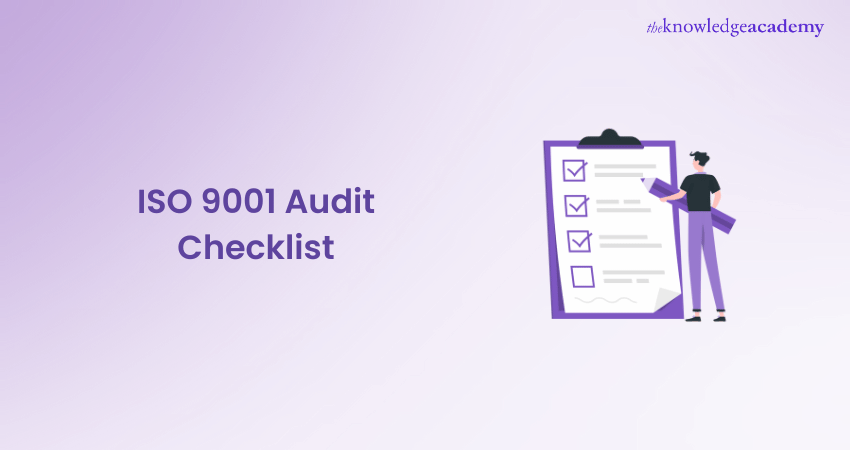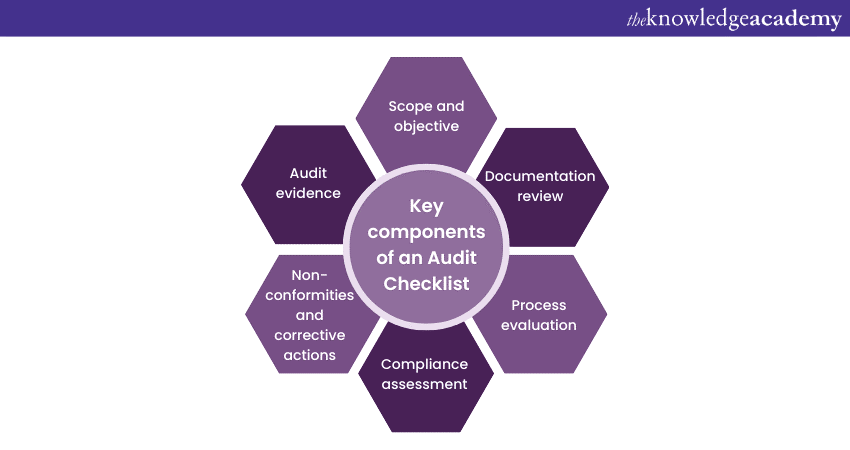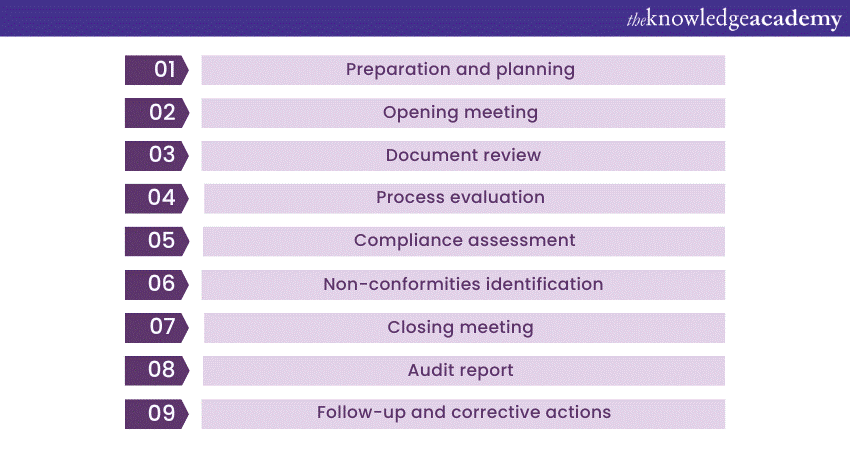We may not have the course you’re looking for. If you enquire or give us a call on +41 315281584 and speak to our training experts, we may still be able to help with your training requirements.
We ensure quality, budget-alignment, and timely delivery by our expert instructors.

Dreading your upcoming ISO 9001 Audit? Stressed about compliance gaps in your Quality Management System (QMS)? An ISO 9001 Audit Checklist can be your knight in shining armour! This informative blog equips you with a comprehensive ISO 9001 Audit Checklist, turning audit prep into a breeze.
We'll provide a detailed breakdown of all essential clauses within the ISO 9001 Standard. By leveraging this checklist, you can pinpoint areas for improvement, streamline the audit process, and showcase the robustness of your QMS. So, ditch the pre-audit jitters! Read this ISO 9001 Audit Checklist today and ensure a smooth, successful audit experience.
Table of Contents
1) What is an ISO 9001 Audit Checklist?
2) How to prepare for an ISO 9001 Audit Checklist?
3) How to conduct the ISO 9001 Audit Checklist?
4) Tips for a successful ISO 9001 Audit Checklist
5) Conclusion
What is an ISO 9001 Audit Checklist?
ISO 9001 is a globally recognised standard for the creation and management of Quality Systems. It serves as a framework that organisations can adopt to design and maintain procedures that ensure their products or services meet established quality benchmarks. The ISO 9001 Audit Checklist plays a pivotal role during audits, providing a comprehensive record of all process components that must conform to the standard.
The checklist is a methodical tool used by Auditors to verify a company’s adherence to the specified criteria. It forms a detailed guide that offers clear instructions to Internal Auditors on the appropriate tools and techniques for conducting thorough audits without overlooking any elements. During an ISO 9001 Audit, the checklist comprises a series of questions or statements designed to facilitate a thorough evaluation in line with the Quality Management Systems.

The primary objective of the Audit Checklist is to generate a correct way of performing an audit. It assists auditors in pinpointing where controls are lacking, assessing how effectively enforced internal Audit processes are, and uncovering non-compliance. Using the ISO 9001 Audit Checklist, ISO 9001 Auditors can ensure that the process of their assessment is consistent, unbiased, and as efficient as possible.
How to prepare for an ISO 9001 Audit Checklist?
The successful completion of the Audit is hinged on early and comprehensive pre-audit planning. Here are some essential steps to consider:
1) Gathering relevant documentation: Gather all necessary documentation with regard to the Quality Management System. This might include laws, regulations, records, third-party audit reports and others. Such reports ease the execution of audits.
2) Identifying key processes and areas to be audited: Pinpoint the essential processes or business areas within the organisation that shall be the subject of the audit. This involves studying areas of higher risk, customer needs and wants, and large quality goals.
3) Assigning audit responsibilities: Allocate responsibilities to the audit such as, a lead auditor and the team members who will support the audit. See to it that the Auditors are qualified, competent for their specific jobs, and have a good reputation.
Want to become a certified Lead Auditor and drive continuous improvement in your organisation? Sign up for our ISO 9001 Course now!
How to conduct the ISO 9001 Audit Checklist?
The ISO 9001 Audit Checklist is the ultimate guide to follow during the audit process. Here are the typical steps involved to conduct the checklist:

Preparation and planning
Initially, it’s essential to establish the scope, objectives, and benchmarks for the audit. This involves gaining a thorough understanding of the ISO 9001 Standard and the organisation’s Quality Management System.
It’s also important to examine past ISO 9001 Internal Audit findings, corrective measures, and pertinent documentation. Crafting a clear and succinct audit strategy is crucial, encompassing the Audit Checklist, the auditor’s timetable, and the required resources.
Opening meeting
Kick off the audit by holding a first meeting to formally introduce Auditors, explain the audit process, and set clear expectations. This meeting will also close any door of queries and confusion faced by the auditees.
Take the first step towards achieving excellence with our ISO 9001 Course – sign up now!
Document review
Make sure to go through the organisation's documented processes, procedures, and records when comparing them to the requirements of ISO 9001. Evaluate whether they are adequate, fully, and in line with the standard. ISO 9001 Documentation ensures that all necessary aspects are covered and comply with the standard's requirements.
Process evaluation
Identify the effectiveness of critical processes through experimentation, establishing performance indexes and talking to the workers. The goal of this appraisal is to determine if there is any need for adjustments or functionality improvement.
Compliance assessment
Determine whether the organisation conforms to the ISO 9001 quality requirements. This involves confirming whether the satisfactory controls, operations and procedures are installed to comply with the standard’s requisites.
Non-conformities identification
After inspecting and auditing the contractor's compliance with regulations, if anything is detected as not in compliance, it should be documented, and the results communicated to the auditee. Deviations from standards could necessitate the identification of root causes andor appropriate remedial measures.
Closing meeting
The closing meeting is the last step in a successful audit. It is the opportunity to discuss all the audit findings and non-conformities; point out any areas of improvement as well in the report. At this meeting, participants will try to get clarity over corrective actions and time for implementation of those actions.
Audit report
Compile a detailed Audit report of your efforts, which contains sections on objectives, scope, methodology, findings and suggestions. Do not forget to include your observations on the parts that deviate and, on the areas, needing reinforcement. Also, consider making this report accommodate the positive parts and the best practices coming from the carried audit. Brief the audit results and how those that tie to the organisation’s strengths and weaknesses.
Take the first step towards becoming an Internal Auditor and enhance your career with our comprehensive ISO 9001 Internal Auditor Course!
Follow-up and corrective actions
Track the organisation's progress in line with the resolutions the auditor recommended. Take up follow-up of the issues highlighted to ensure that the right measures have been put in place to solve them. Offer direction and assistance during the process of revising, if appropriate, to ensure that corrective measures are taken promptly.
Having done that, Auditors can perform a comprehensive ISO 90001 Audit Checklist. It guarantees the system`s conformity to the ISO 9001 model, pinpoints the weak areas, and cultivates a culture of constant improvement at the organisational level. This process highlights the Benefits of ISO 9001, ensuring enhanced efficiency and quality.
Tips for a successful ISO 9001 Audit Checklist
To ensure a successful Audit Checklist, one needs to consider the following tips:
1) Communication and collaboration: Keep the auditee in the loop and exchange feedback on current issues while the audit is underway. Partner and get to grips with the most vital stakeholders to get a holistic picture of the organisation's Quality Management System.
2) Thorough documentation review: Make sure you are keen on the organisation's ISO 9001 Documentation throughout the audit process. Verify that the practice docs are in line with the ISO 9001 Requirements and accurately reflect what is practised within the organisation.
3) Objective evaluation: Throughout the audit it is necessary to remain objective and impartial. Show your evaluations from evidence and facts, and not by personal opinions or biases.
4) Timely corrective actions: Motivate the Auditee to take immediate corrective measures in those areas where any non-conformities are identified. Strict implementation of on-time non-conformities acceptance represents a way of demonstrating the dedication to continuous improvement.
Conclusion
The ISO 9001 Audit Checklist is an invaluable tool for organisations seeking to assess their compliance with ISO 9001 Standards. It facilitates a systematic approach to auditing, leading to a thorough and precise evaluation of operational conformity with the Quality Management framework. By following the checklist and implementing recommended improvements, companies can enhance their Quality Management System (QMS) and realize ongoing enhancement.
Want to unlock your organisation's potential? Sign up for our comprehensive ISO 9001 Certification today!
Frequently Asked Questions
How many records does ISO 9001 require?

The ISO 9001 Standard mandates four documents and 18 records; however, any of these can be excluded from the list if they are not applicable to the scope of the Quality Management System.
What are the 6 mandatory procedures for ISO 9001?

Here are the mandatory procedures required for ISO 9001 compliance
1) Control of documents
2) Control of records
3) Internal audit
4) Corrective action
5) Preventive action
6) Control of non-conforming products
What are the other resources and offers provided by The Knowledge Academy?

The Knowledge Academy takes global learning to new heights, offering over 3,000 online courses across 490+ locations in 190+ countries. This expansive reach ensures accessibility and convenience for learners worldwide.
Alongside our diverse Online Course Catalogue, encompassing 19 major categories, we go the extra mile by providing a plethora of free educational Online Resources like News updates, Blogs, videos, webinars, and interview questions. Tailoring learning experiences further, professionals can maximise value with customisable Course Bundles of TKA.
What is the Knowledge Pass, and how does it work?

The Knowledge Academy’s Knowledge Pass, a prepaid voucher, adds another layer of flexibility, allowing course bookings over a 12-month period. Join us on a journey where education knows no bounds.
What are related Courses and blogs provided by The Knowledge Academy?

The Knowledge Academy offers various ISO 9001 Certification Courses, including ISO 9001 Foundation Course, ISO 9001 Lead Auditor Course and ISO 9001 Internal Auditor Course. These courses cater to different skill levels, providing comprehensive insights into ISO 9001 Documentation Requirement: A Complete Guide.
Our Business Improvement Blogs covers a range of topics offering valuable resources, best practices, and industry insights. Whether you are a beginner or looking to advance your Business Improvement skills, The Knowledge Academy's diverse courses and informative blogs have you covered.
Upcoming Business Improvement Resources Batches & Dates
Date
 ISO 9001 Foundation course
ISO 9001 Foundation course
Mon 7th Apr 2025
Mon 12th May 2025
Mon 2nd Jun 2025
Mon 7th Jul 2025
Mon 4th Aug 2025
Mon 1st Sep 2025
Mon 20th Oct 2025
Mon 10th Nov 2025
Mon 1st Dec 2025






 Top Rated Course
Top Rated Course



 If you wish to make any changes to your course, please
If you wish to make any changes to your course, please


